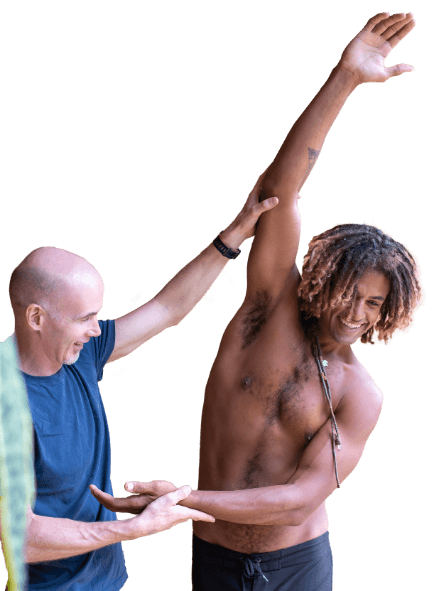
Osteopath and Lifestyle Medicine Coach Ed Paget shares his expertise on how to avoid – or reverse – the midlife health slump and weight gain.
I’m now firmly in middle age.
From the little hair I still have, I can see it’s gray; there are a few wrinkles around my eyes, but I’m the same weight as I was when I was 21, maybe even a little lighter. The same is different for my friend group. The ‘spare tire’ seems to get bigger yearly, and the health complaints keep mounting. Most think it is an inevitable part of aging, but, as I’ll explain below, it isn’t inevitable; it isn’t due to genes, falling testosterone levels or getting older.
From a physiological point of view, our ability to gain muscle decreases as we age.
If we don’t actively seek to keep them, our muscles will tend to waste, and the scientific term for this is sarcopenia. Decreased muscle mass means we need less energy, which can also change our body’s ability to handle sugar. Muscles are a great way to use sugar quickly; less of it means excess sugar will be converted to fat. We will gain weight if we don’t match our caloric intake with our caloric needs. As we discover, extra fat can produce hormones, and the added stress of middle-aged responsibilities can dysregulate our normal hormonal rhythms. These are the confluence of factors that lead to the “dad bod.”
Simply put: Decreased muscle from inactivity plus no change or increased calories consumed equals more fat storage.Add to this the stresses of middle age, and we have hormonal dysregulation, high blood pressure, decreased mental well-being, and a host of other physical and psychological problems that affect men in their 40s, 50s, and 60s.
But there is good news—these five tips have been well-proven to reverse these physical and mental changes; we need to follow them.
A sedentary lifestyle significantly contributes to weight gain even when we don’t lose muscle. Put bluntly, the World Health Organization (WHO) estimates that physical inactivity is responsible for around two million deaths annually. It warns it could be among the top ten leading causes of death and disability worldwide. Regular physical activity reduces the risk of cardiovascular diseases, diabetes, obesity, and mental health disorders.
Actionable Tip: Start with small, achievable goals to incorporate more movement into your daily routine. Simple actions like doing one press-up or squat a day or taking a five-minute run to build a habit of regular activity.
The 19th-century athlete Walter George spent long hours working as a pharmacist and, as a result, couldn’t train. Instead, he started running on the spot between customers. He attributed this training method to his success. He held the world record for running the quickest mile, which wasn’t beaten for 30 years!
To counteract muscle loss, we need to do something involving resistance. That means moving something that isn’t easily moved, like a weight or band. Not only does it help with weight management, but it also improves balance and coordination and keeps the hormones running just fine. Compared to men in their 20s, only a tiny percentage of middle-aged men meet the recommended guidelines for muscle-strengthening activities. This can be due to the busyness of work and family commitments. However, I always questioned people about how busy they were, and after 20 years of coaching, I usually found a time that people could exercise.
Actionable Tips:
Simple exercises like squats and lunges can also be done at home; make it a habit. Strength training just twice a week can significantly improve muscle mass and overall health.
Many middle-aged men shift from binge drinking in their youth to more consistent, daily alcohol consumption. In a recent interview on my podcast, Your Lifestyle Is Your Medicine, I interviewed Kevin Smith (45), who was drinking five days a week and feeling the spread of middle age. He had an epiphany about two years ago when he realized his groggy mornings were why he was seeking out bad food and not going to the gym. Once he cut back and stopped drinking, he had the energy to change his diet and go to the gym. He joined a Cross Fit gym, and he’s been there ever since. Now, he’s the strongest he’s ever been while rocking the body of a 20-year-old.
Actionable Tip: What Kevin did is not for everybody. Many people believe that giving up alcohol may seem like social suicide, but the group “One Year No Beer” advocates a more moderate approach, limiting your alcohol intake to special occasions and avoiding making it a daily habit. They are also an excellent resource for those wanting to re-examine their relationship with alcohol. Also, with the advent of decent-tasting non-alcoholic options, not drinking doesn’t mean not socializing.
Like my old science teacher told me, this is boring but important. The modern food environment is filled with ultra-processed foods (UPFs) high in fat, sugar, and salt. These foods might lie at the core of our current obesity and heart disease epidemics. Our brain is wired to seek sugar, salt, and fat. When we were evolving, these foods were in short supply but provided essential calories and nutrients for survival. We still have the legacy of our more primitive brain coupled with our ingenious ability to satisfy it…and turn a profit at the same time. Unfortunately, these highly addictive foods are marketed aggressively and can contribute to weight gain and other health issues.
Actionable Tip: Make a habit of reading food labels and choosing whole, minimally processed foods. Prepare meals at home using fresh ingredients, and be cautious of foods with long ingredient lists or those high in additives. Prioritizing nutrient-dense foods over convenience options can significantly improve your diet. It might sound a little preachy, but finding time to cook with fresh food is one of the best things you can do for your body. If you genuinely have no time, there are some great resources to become more efficient, with companies like ‘Hello Fresh’ in the UK, delivering fresh food to your house or ‘Dashing Dishes’ offering meal kits for pick up in Canada.
A study in the British Medical Journal found that cognitive decline can begin as early as 45, meaning that we have to keep our brains active as we age. Interestingly, the better we are at something, the less we use our brains. For example, a 2003 study in NeuroImage agreed with other studies when it showed that professional musicians used a smaller area of their brain than amateur musicians to play music. This means the mental effort it takes to learn music or even a language is more significant than playing or speaking when you are fluent. The act of leaning stimulates the brain.
Actionable Tip: Engaging in mentally stimulating activities like puzzles and board games will help but as Dr Tommy Wood, associate professor of Neurology at Washington University, recently said on my podcast, it doesn’t compare to learning something new like a language or dance. Along with training the brain, we should maintain social connections by scheduling regular meetups with friends or joining clubs and community groups. Activities that combine physical and mental engagement, such as playing sports or attending classes, are particularly beneficial. I’ve noticed a massive uptake in a game called Pickleball in my community. I’ve seen people who had a myriad of health complaints, from high blood pressure and reflux to high cholesterol, get the medical all-clear by losing 10lbs and running around a bit.
Middle age doesn’t have to mean inevitable weight gain and physical decline. By staying active, incorporating strength training, moderating alcohol consumption, making mindful food choices, and maintaining mental and social health, men can defy the myth of unavoidable middle age spread and enjoy a healthier, more vibrant life. Remember, the key is consistency and making sustainable lifestyle changes.
References

Over the last 10 years Ed has been building a YouTube library to help people manage their own pain or movement limitations and increase performance through exercise. He regularly adds videos so be sure to subscribe and visit regularly


"Oh My Gosh- I am ALREADY feeling relief after a few days! I used to wake up 2-3 times a night with shooting pain that anti inflammatories couldn't touch. Now I have been waking up just because I want to notice what it feels like to lay in bed pain free- THANK YOU!."

"When I first started with your program I was experience a lot of pain. Walking was difficult. I had to stop and catch my breath every few minutes and lean against a wall for support. Now when I walk with my husband we go for over an hour. I never had to sit down and stop...and, hardly any pain!!! 😊😊 I can’t thank you enough."
Frustrated that you aren't recovering fast enough?
Discover how to heal from illness and injury using movement, food and lifestyle.